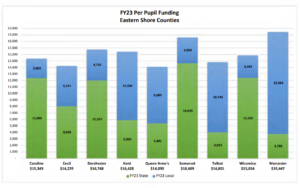
SNOW HILL– A review provided to county officials this week shows that public education in Worcester County costs about $27,000 per pupil.
A presentation to the Worcester County Commissioners this week analyzes school system funding as it relates to implementation of the Blueprint for Maryland’s Future. According to county staff, Blueprint implementation shouldn’t cost the county any more than it’s already providing with the current Maintenance of Effort (MOE) funding formula.
“The state is subject to change in each legislative session the overall process or what the funding requirements are, but at this point in time Maintenance of Effort for the requirements at this fiscal year, they estimate it costs $70.7 million to implement the requirements of the Blueprint,” Chief Administrative Officer Weston Young said. “We are funding $100 million.”
As the changes required by the Blueprint for Maryland’s Future move forward, Young provided the commissioners this week with a presentation reviewing the Maintenance of Effort funding formula as well as the new Local Share formula. He said that historically, funding for the school system has been driven by the funding formula known as MOE.
“The funding provided by the county per pupil in the previous year sets the bar for the future year,” Young said.
He told the commissioners the Blueprint added a new “Local Share” funding formula that’s meant to support implementation of the various goals of the five pillars that make up the Blueprint.
“Local share is phased in over time,” he said, explaining that the amount represented the estimated cost to implement the Blueprint.
According to new state law, counties have to fund either the Local Share amount or the MOE amount—whichever is larger. For the current year, Worcester County’s Local Share is calculated at $70.7 million, as that is the estimated cost to begin implementation of the Blueprint. The county’s MOE funding level is currently $100 million.
“Maintenance of Effort is our minimum local effort in terms of funding as it is the greater of the two,” Young said.
While 12-year projections show the Local Share in some counties eventually exceeding MOE, in Worcester County the Local Share will remain below MOE funding levels.
“It should be noted too that when this was run it did not take into consideration the $3 million above Maintenance of Effort that the county gave to the board of ed in fiscal year 2023,” Young said. “I think that’s just going to further solidify Maintenance of Effort is going to the funding formula for the near future.”
He pointed out that state requirements could change and that the state could even force counties to take on more costs, as it did when counties took over teacher pension funding.
“Even the state’s fund balance, which has already started to tank at this point, goes into a projected deficit in FY 2027 due to Blueprint commitments and recommendations. The state has shown in the past it’s more than willing to pass these costs down to the counties.”
Showing a slide of the nine Eastern Shore counties, Young said Worcester received the least amount of state funding and provided the highest amount of local funding.
“You will see Worcester’s receiving the lowest state contribution per pupil at $3,783,” Young said. “We are followed by Talbot, Queen Anne’s and Kent. This is tied to the wealth formula. Ultimately it is the wealth per pupil. Because we have less students the formula impacts us the worst. On the high end of the Eastern Shore counties, our neighbors in Somerset get $14,659 per pupil from the state.”
As far as local funding, Worcester County provides $15,664 per pupil, nearly $5,000 more per pupil than the next highest county, Talbot, which provides $10,748.
“Combined with local and state funding, Worcester sits at number one among the Eastern Shore counties in per pupil funding with $19,447 per pupil,” Young said. “The average among the nine up there is a little over $16,000.”
According to Young, once school construction debt and health benefit costs (other post-employment benefits) paid by the county are taken into account and combined with the state and grant funding the school system received, public education in Worcester cost $27,281 per pupil in fiscal year 2023.
Moving forward, he said he wanted the commissioners to understand that from the state’s perspective, the Blueprint funding was not meant to come on top of existing funding. He said the head of the Blueprint for Maryland’s Future Accountability & Implementation Board made that clear at a recent Maryland Association of Counties event.
“She explained they’re meant to be replacements, or reconfiguring of how certain things are done today,” he said. “They’re changing how various parameters are judged and are to be implemented. Not on top of what they do now but a replacement of certain things. Local share is the estimated cost to implement these improvements.”
Young said that because Worcester had typically funded above the MOE level, its MOE rate was sufficient to fund the Blueprint changes and would likely stay that way.
“By simply funding the Maintenance of Effort rate, we are currently now and projected to fund over the amount required to implement the Blueprint,” he said.

